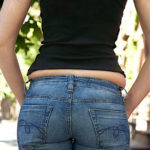Jeans are a fashion staple across all ages and social classes. Their popularity stems from their simple design and versatility, suitable for various occasions. Additionally, the durable denim fabric flatters the wearer’s figure and never goes out of style.
There are many interesting design elements to jeans that often go unnoticed, such as the small leather patch on the back.
This patch, called a jacron, is typically rectangular and sewn onto the waistband, slightly offset to one side. Most jean brands feature this detail, and its presence has become familiar. But what is the significance of this small patch, and is it merely decorative or something more?
It’s no exaggeration to say that these small leather patches on the back waistband are a unique “signature” of jeans. Despite their small size and discreet location, they serve a crucial purpose.

Firstly, the jacron is a “brand identifier,” allowing wearers to instantly recognize the jean brand. While small in size, these patches are carefully and elegantly designed, adding a unique decorative touch to the jeans. This simple yet effective strategy enhances brand advertising for manufacturers, while wearers can subtly showcase their expensive taste.
Moreover, luxury brands often utilize these patches to display their logos, helping customers distinguish authentic products from counterfeits. By featuring their logo or distinctive symbol on the patch, brands can promote their products while making it challenging for imitators to replicate their designs.
Notably, some jean brands allow customers to create customized jacrons, enabling them to express their unique personalities and add a touch of individuality to their jeans.
Levi’s, a pioneering brand in this regard, introduced this design element in 1873, featuring a small fabric patch with their logo and symbol on the outside of their jeans, in addition to the inner label. Other brands followed suit, and soon, these small patches became an expected detail on jeans.
Why do jeans always have that tiny pocket on the front?
Jeans come in various styles and colors, but one consistent feature is the tiny pocket on the front hip. This pocket is too small to be practical for storing or retrieving items, leading to speculation about its purpose. Some guess it might be for coins, tickets, or a small candy.
However, the true reason behind this design element is revealed by Levis, the authority on jeans, on their website: “The tiny pocket on jeans was designed to protect pocket watches. After that, the pocket began to be used for other things like coins, candy, and train tickets.”
In the 19th century, when pocket watches were common before the widespread use of wristwatches, Levi Strauss, the creator of the Levi’s brand, designed jeans for laborers and cowboys in 1873, including this small pocket to hold their pocket watches. This pocket is also known as a fob pocket.
As jeans gained popularity, people began using the tiny pocket for various small items like coins, keys, or simply as a stylish accent to their outfit.
Source: Nguoiduatin
Keeping Items in Good Condition: What to Clean Less Often
Maintaining household items often requires more than just a quick clean – some items need specific care in order to keep them at their best. From towels to microwaves, pajamas to jeans, there are certain measures one can take to ensure these products last longer and remain in their best condition.






































